Degradation of Perfluorododecyl-Iodide Self-Assembled Monolayers upon Exposure to Ambient Light
Abstract
:1. Introduction
2. Materials and Methods
2.1. Substrate Preparation
2.2. SAM Characterization
3. Results
3.1. Optimal I-PFC12 SAM Deposition
3.2. I-PFC12 Degradation under X-rays
3.3. I-PFC12 Deposited on SiO2
3.4. I-PFC12 Deposited on TiO2
4. Discussion
5. Conclusions
Supplementary Materials
Author Contributions
Funding
Data Availability Statement
Acknowledgments
Conflicts of Interest
References
- Bencher, C.; Chen, Y.; Dai, H.; Montgomery, W.; Huli, L. 22nm Half-Pitch Patterning by CVD Spacer Self Alignment Double Patterning (SADP). In Proceedings of the SPIE Advanced Lithography Symposium, San Jose, CA, USA, 24–29 February 2008; Volume 6924, pp. 1440–1446. [Google Scholar] [CrossRef]
- Hobbs, R.G.; Petkov, N.; Holmes, J.D. Semiconductor Nanowire Fabrication by Bottom-up and Top-down Paradigms. Chem. Mater. 2012, 24, 1975–1991. [Google Scholar] [CrossRef]
- Vandeweyer, T.; Bekaert, J.; Ercken, M.; Gronheid, R.; Miller, A.; Truffert, V.; Verhaegen, S.; Versluijs, J.; Wiaux, V.; Wong, P.; et al. Immersion Lithography and Double Patterning in Advanced Microelectronics. In Proceedings of the International Conference on Micro- and Nano-Electronics, Zvenigorod, Russia, 5–9 October 2009; Volume 7521. [Google Scholar] [CrossRef]
- Moore, G.E. Cramming More Components onto Integrated Circuits. Proc. IEEE 1998, 86, 82–85. [Google Scholar] [CrossRef]
- Schaller, R.R. Moore’s Law: Past, Present, and Future. IEEE Spectr. 1997, 34, 52–56. [Google Scholar] [CrossRef]
- Sharma, E.; Rathi, R.; Misharwal, J.; Sinhmar, B.; Kumari, S.; Dalal, J.; Kumar, A. Evolution in Lithography Techniques: Microlithography to Nanolithography. Nanomaterials 2022, 12, 2754. [Google Scholar] [CrossRef] [PubMed]
- Mackus, A.J.M.; Merkx, M.J.M.; Kessels, W.M.M. From the Bottom-Up: Toward Area-Selective Atomic Layer Deposition with High Selectivity. Chem. Mater. 2019, 31, 2–12. [Google Scholar] [CrossRef] [PubMed]
- Gabor, A.H.; Felix, N.M. Overlay Error Statistics for Multiple-Exposure Patterning. J. Micro/Nanolithogr. MEMS MOEMS 2019, 18, 021202. [Google Scholar] [CrossRef]
- Peterhänsel, S.; Gödecke, M.L.; Paz, V.F.; Frenner, K.; Osten, W. Detection of Overlay Error in Double Patterning Gratings Using Phase-Structured Illumination. Opt. Express 2015, 23, 24246. [Google Scholar] [CrossRef]
- Bhattacharyya, K. Tough Road Ahead for Device Overlay and Edge Placement Error. In Proceedings of the SPIE Advanced Lithography Symposium, San Jose, CA, USA, 24–28 February 2019; p. 1095902. [Google Scholar] [CrossRef]
- Harriott, L.R. Limits of Lithography. Proc. IEEE 2001, 89, 366–374. [Google Scholar] [CrossRef]
- Iyengar, V.V.; Chandrasekaran, S.; Weddington, D.; Nettles, M.M.; Eagle, O.H.; Tey, S.H.; Parry, T.B. Collapse-Free Patterning of High Aspect Ratio Silicon Structures for 20nm NAND Flash Technology. In Proceedings of the 2015 26th Annual SEMI Advanced Semiconductor Manufacturing Conference (ASMC), New York, NY, USA, 3–6 May 2015; pp. 53–57. [Google Scholar] [CrossRef]
- Jeong, K.; Kahng, A.B.; Topaloglu, R.O. Assessing Chip-Level Impact of Double Patterning Lithography. In Proceedings of the 2010 11th International Symposium on Quality Electronic Design (ISQED), San Jose, CA, USA, 22–24 March 2010; pp. 122–130. [Google Scholar] [CrossRef]
- Bakshi, V. EUV Lithography; SPIE: Bellingham, WA, USA, 2009. [Google Scholar] [CrossRef]
- Levinson, H.J. High-NA EUV Lithography: Current Status and Outlook for the Future. Jpn. J. Appl. Phys. 2022, 61, SD0803. [Google Scholar] [CrossRef]
- Manouras, T.; Argitis, P. High Sensitivity Resists for EUV Lithography: A Review of Material Design Strategies and Performance Results. Nanomaterials 2020, 10, 1593. [Google Scholar] [CrossRef]
- Closser, K.D.; Ogletree, D.F.; Naulleau, P.; Prendergast, D. The Importance of Inner-Shell Electronic Structure for Enhancing the EUV Absorption of Photoresist Materials. J. Chem. Phys. 2017, 146, 164106. [Google Scholar] [CrossRef] [PubMed]
- Kostko, O.; Xu, B.; Ahmed, M.; Slaughter, D.S.; Frank Ogletree, D.; Closser, K.D.; Prendergast, D.G.; Naulleau, P.; Olynick, D.L.; Ashby, P.D.; et al. Fundamental Understanding of Chemical Processes in Extreme Ultraviolet Resist Materials. J. Chem. Phys. 2018, 149, 154305. [Google Scholar] [CrossRef] [PubMed]
- Pasquali, M.; Brady-Boyd, A.; Leśniewska, A.; Carolan, P.; Conard, T.; O’Connor, R.; De Gendt, S.; Armini, S. Area-Selective Deposition of AlOx and Al-Silicate for Fully Self-Aligned via Integration. ACS Appl. Mater. Interfaces 2023, 15, 6079–6091. [Google Scholar] [CrossRef] [PubMed]
- Parsons, G.N.; Clark, R.D. Area-Selective Deposition: Fundamentals, Applications, and Future Outlook. Chem. Mater. 2020, 32, 4920–4953. [Google Scholar] [CrossRef]
- Yarbrough, J.; Shearer, A.B.; Bent, S.F. Molecule Inhibitors for Area-Selective Atomic Layer. J. Vac. Sci. Technol. A 2023, 39, 021002. [Google Scholar] [CrossRef]
- Johnson, R.W.; Hultqvist, A.; Bent, S.F. A Brief Review of Atomic Layer Deposition: From Fundamentals to Applications. Mater. Today 2014, 17, 236–246. [Google Scholar] [CrossRef]
- Bobb-Semple, D.; Nardi, K.L.; Draeger, N.; Hausmann, D.M.; Bent, S.F. Area-Selective Atomic Layer Deposition Assisted by Self-Assembled Monolayers: A Comparison of Cu, Co, W, and Ru. Chem. Mater. 2019, 31, 1635–1645. [Google Scholar] [CrossRef]
- Schreiber, F. Structure and Growth of Self-Assembling Monolayers. Prog. Surf. Sci. 2000, 65, 151–257. [Google Scholar] [CrossRef]
- Bain, C.D.; Whitesides, G.M. A Study by Contact Angle of the Acid-Base Behavior of Monolayers Containing ω-Mercaptocarboxylic Acids Adsorbed on Gold: An Example of Reactive Spreading. Langmuir 1989, 5, 1370–1378. [Google Scholar] [CrossRef]
- Bain, C.D.; Troughton, E.B.; Tao, Y.T.; Evall, J.; Whitesides, G.M.; Nuzzo, R.G. Formation of Monolayer Films by the Spontaneous Assembly of Organic Thiols from Solution onto Gold. J. Am. Chem. Soc. 1989, 111, 321–335. [Google Scholar] [CrossRef]
- Nuzzo, R.G.; Allara, D.L. Adsorption of Bifunctional Orgnaic Disulfides on Gold Surfaces. J. Am. Chem. Soc. 1983, 105, 4481–4483. [Google Scholar] [CrossRef]
- Jo, K.; Yang, H. Comparative Study of Stability of Phosphonate Self-Assembled Monolayers on Indium-Tin Oxide Electrodes Prepared Using Different Methods. J. Electroanal. Chem. 2014, 712, 8–13. [Google Scholar] [CrossRef]
- Jennings, G.K.; Laibinis, P.E. Self-Assembled Monolayers of Alkanethiols on Copper Provide Corrosion Resistance in Aqueous Environments. Colloids Surf. A Physicochem. Eng. Asp. 1996, 116, 105–114. [Google Scholar] [CrossRef]
- Lee, S.; Shon, Y.-S.; Colorado, R.; Guenard, R.L.; Lee, T.R.; Perry, S.S. The Influence of Packing Densities and Surface Order on the Frictional Properties of Alkanethiol Self-Assembled Monolayers (SAMs) on Gold: A Comparison of SAMs Derived from Normal and Spiroalkanedithiols. Langmuir 2000, 16, 2220–2224. [Google Scholar] [CrossRef]
- de Boer, B.; Hadipour, A.; Mandoc Magdalena, M.; van Woudenbergh, T.; Blom, P. Tuning of Metal Work Functions with Self-Assembled Monolayers. Adv. Mater. 2005, 17, 621–625. [Google Scholar] [CrossRef]
- Yan, L.; Zhao, X.M.; Whitesides, G.M. Patterning a Preformed, Reactive SAM Using Microcontact Printing. J. Am. Chem. Soc. 1998, 120, 6179–6180. [Google Scholar] [CrossRef]
- Ghezzi, M.; Thickett, S.C.; Neto, C. Early and Intermediate Stages of Guided Dewetting in Polystyrene Thin Films. Langmuir 2012, 28, 10147–10151. [Google Scholar] [CrossRef]
- Zhao, B.; Moore, J.S.; Beebe, D.J. Surface-Directed Liquid Flow inside Microchannels. Science 2001, 291, 1023–1026. [Google Scholar] [CrossRef] [PubMed]
- Gau, H.; Herminghaus, S.; Lenz, P.; Lipowsky, R. Liquid Morphologies on Structured Surfaces: From Microchannels to Microchips. Science 1999, 283, 46–49. [Google Scholar] [CrossRef]
- Mrksich, M.; Chen, C.S.; Xia, Y.; Dike, L.E.; Ingber, D.E.; Whitesides, G.M. Controlling Cell Attachment on Contoured Surfaces with Self-Assembled Monolayers of Alkanethiolates on Gold. Proc. Natl. Acad. Sci. USA 1996, 93, 10775–10778. [Google Scholar] [CrossRef]
- Lodha, J.K.; Pollentier, I.; Conard, T.; Vallat, R.; De Gendt, S.; Armini, S. Self-Assembled Monolayers as Inhibitors for Area-Selective Deposition: A Novel Approach towards Resist-Less EUV Lithography. Appl. Surf. Sci. 2022, 606, 154657. [Google Scholar] [CrossRef]
- Shou, K.; Hong, J.K.; Wood, E.S.; Hook, J.M.; Nelson, A.; Yin, Y.; Andersson, G.G.; Abate, A.; Steiner, U.; Neto, C. Ultralow Surface Energy Self-Assembled Monolayers of Iodo-Perfluorinated Alkanes on Silica Driven by Halogen Bonding. Nanoscale 2019, 11, 2401–2411. [Google Scholar] [CrossRef]
- Abate, A.; Dehmel, R.; Sepe, A.; Nguyen, N.L.; Roose, B.; Marzari, N.; Hong, J.K.; Hook, J.M.; Steiner, U.; Neto, C. Halogen-Bond Driven Self-Assembly of Perfluorocarbon Monolayers on Silicon Nitride. J. Mater. Chem. A 2019, 7, 24445–24453. [Google Scholar] [CrossRef]
- Cavallo, G.; Metrangolo, P.; Milani, R.; Pilati, T.; Priimagi, A.; Resnati, G.; Terraneo, G. The Halogen Bond. Chem. Rev. 2016, 116, 2478–2601. [Google Scholar] [CrossRef] [PubMed]
- Gutzler, R.; Fu, C.; Dadvand, A.; Hua, Y.; MacLeod, J.M.; Rosei, F.; Perepichka, D.F. Halogen Bonds in 2D Supramolecular Self-Assembly of Organic Semiconductors. Nanoscale 2012, 4, 5965–5971. [Google Scholar] [CrossRef]
- Wang, F.; Ma, N.; Chen, Q.; Wang, W.; Wang, L. Halogen Bonding as a New Driving Force for Layer-by-Layer Assembly. Langmuir 2007, 23, 9540–9542. [Google Scholar] [CrossRef]
- Desiraju, G.R.; Ho, P.S.; Kloo, L.; Legon, A.C.; Marquardt, R.; Metrangolo, P.; Politzer, P.; Resnati, G.; Rissanen, K. Definition of the Halogen Bond. Chem. Int. 2023, 45, 30. [Google Scholar] [CrossRef]
- Ochiai, T.; Iizuka, Y.; Nakata, K.; Murakami, T.; Tryk, D.A.; Koide, Y.; Morito, Y.; Fujishima, A. Efficient Decomposition of Perfluorocarboxylic Acids in Aqueous Suspensions of a TiO2 Photocatalyst with Medium-Pressure Ultraviolet Lamp Irradiation under Atmospheric Pressure. Ind. Eng. Chem. Res. 2011, 50, 10943–10947. [Google Scholar] [CrossRef]
- Wang, Y.; Wang, C.; Luo, P.; Hu, Q. Removal of Perfluorooctanoic Acid by MWCNT-Modified Carbon-Doped Titanium Dioxide in a Peroxymonosulfate/Simulated Sunlight System. Appl. Surf. Sci. 2023, 614, 156251. [Google Scholar] [CrossRef]
- Shirley, D.A. High-Resolution X-Ray Photoemission Spectrum of the Valence Bands of Gold. Phys. Rev. B 1972, 5, 4709–4714. [Google Scholar] [CrossRef]
- Brady-Boyd, A.; O’Connor, R.; Armini, S.; Selvaraju, V.; Pasquali, M.; Hughes, G.; Bogan, J. The Role of Atomic Oxygen in the Decomposition of Self-Assembled Monolayers during Area-Selective Atomic Layer Deposition. Appl. Surf. Sci. 2022, 586, 152679. [Google Scholar] [CrossRef]
- Satulu, V.; Ionita, M.D.; Vizireanu, S.; Mitu, B.; Dinescu, G. Plasma Processing with Fluorine Chemistry for Modification of Surfaces Wettability. Molecules 2016, 21, 1711. [Google Scholar] [CrossRef] [PubMed]
- Lee, J.; Woo, H.; Kwon, K. Applied Surface Science Sidewall Chemical Analysis of Plasma-Etched Nano-Patterns Using Tilted X-Ray Photoelectron Spectroscopy Combined with in-Situ Ion Sputtering. Appl. Surf. Sci. 2021, 545, 148907. [Google Scholar] [CrossRef]
- Yang, H.; Guo, J.; Sathe, C.; Agui, A.; Nordgren, J. Structural and Electronic Properties of Low Dielectric Constant Fluorinated Amorphous Carbon Films. Appl. Phys. Lett. 1998, 72, 3353–3355. [Google Scholar] [CrossRef]
- Tressaud, A.; Durand, E.; Labrugère, C.; Alexander, P.; Simbirtseva, G.V.; Kharitonova, L.N.; Dubois, M.; Tressaud, A.; Durand, E.; Labrugère, C.; et al. Surface Modification of Polymers Treated by Various Fluorinating Media. Acta Chim. Slov. 2013, 60, 495–504. [Google Scholar] [PubMed]
- Chen, G.; Zhang, J.; Yang, S. Fabrication of Hydrophobic Fluorinated Amorphous Carbon Thin Films by an Electrochemical Route. Electrochem. Commun. 2008, 10, 7–11. [Google Scholar] [CrossRef]
- Schneider, J.; Matsuoka, M.; Takeuchi, M.; Zhang, J.; Horiuchi, Y.; Anpo, M.; Bahnemann, D.W. Understanding TiO2 Photocatalysis Mechanisms and Materials. Chem. Rev. 2014, 114, 9919–9986. [Google Scholar] [CrossRef] [PubMed]
- Yamijala, S.S.R.K.C.; Shinde, R.; Wong, B.M. Real-Time Degradation Dynamics of Hydrated per- And Polyfluoroalkyl Substances (PFASs) in the Presence of Excess Electrons. Phys. Chem. Chem. Phys. 2020, 22, 6804–6808. [Google Scholar] [CrossRef] [PubMed]
- Vinoda, B.M.; Vinuth, M.; Bodke, Y.D.; Manjanna, J. Photocatalytic Degradation of Toxic Methyl Red Dye Using Silica Nanoparticles Synthesized from Rice Husk Ash. J. Environ. Anal. Toxicol. 2015, 5, 1000336. [Google Scholar] [CrossRef]
- Liu, J.; Van Hoomissen, D.J.; Liu, T.; Maizel, A.; Huo, X.; Fernández, S.R.; Ren, C.; Xiao, X.; Fang, Y.; Schaefer, C.E.; et al. Reductive Defluorination of Branched Per- and Polyfluoroalkyl Substances with Cobalt Complex Catalysts. Environ. Sci. Technol. Lett. 2018, 5, 289–294. [Google Scholar] [CrossRef]

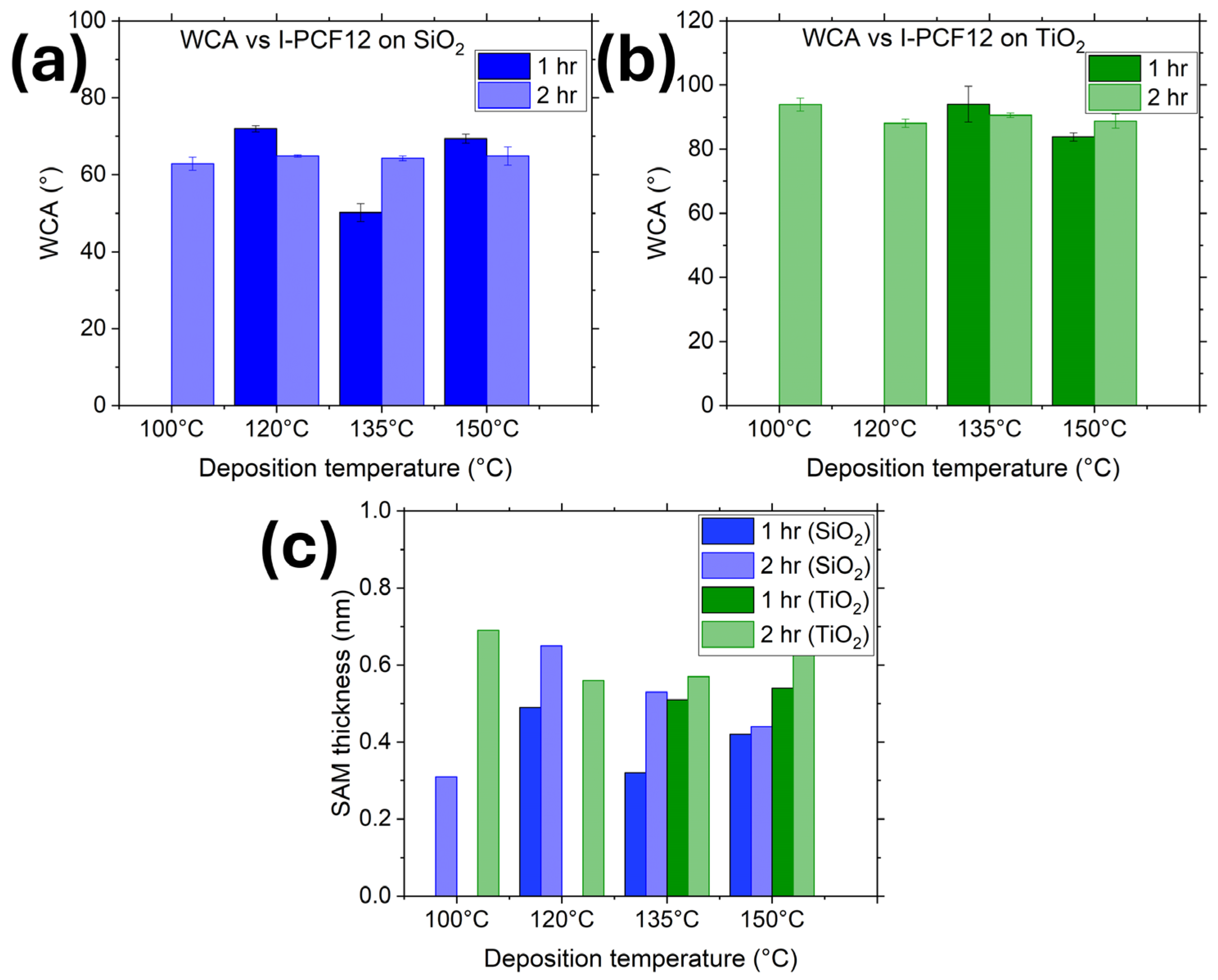
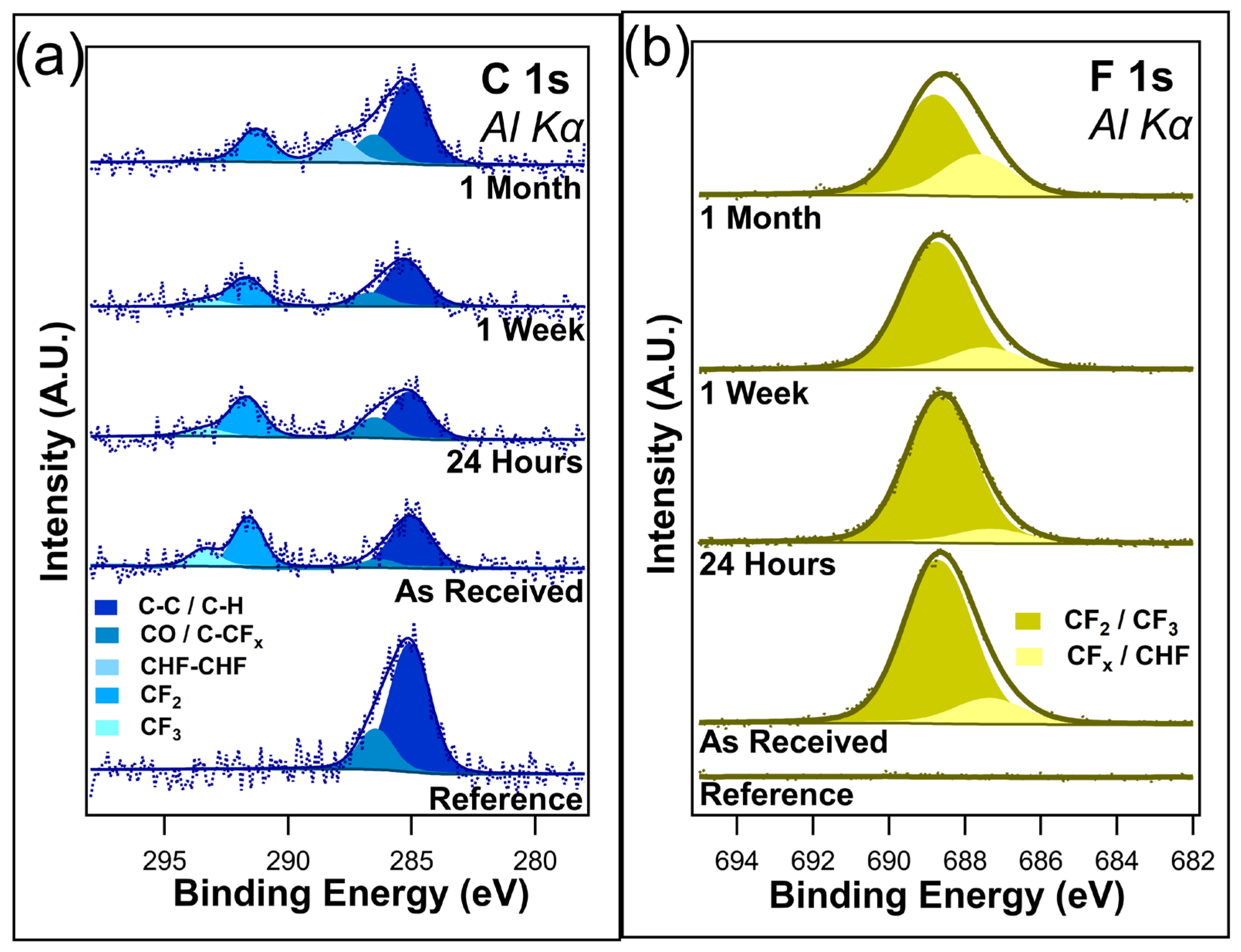
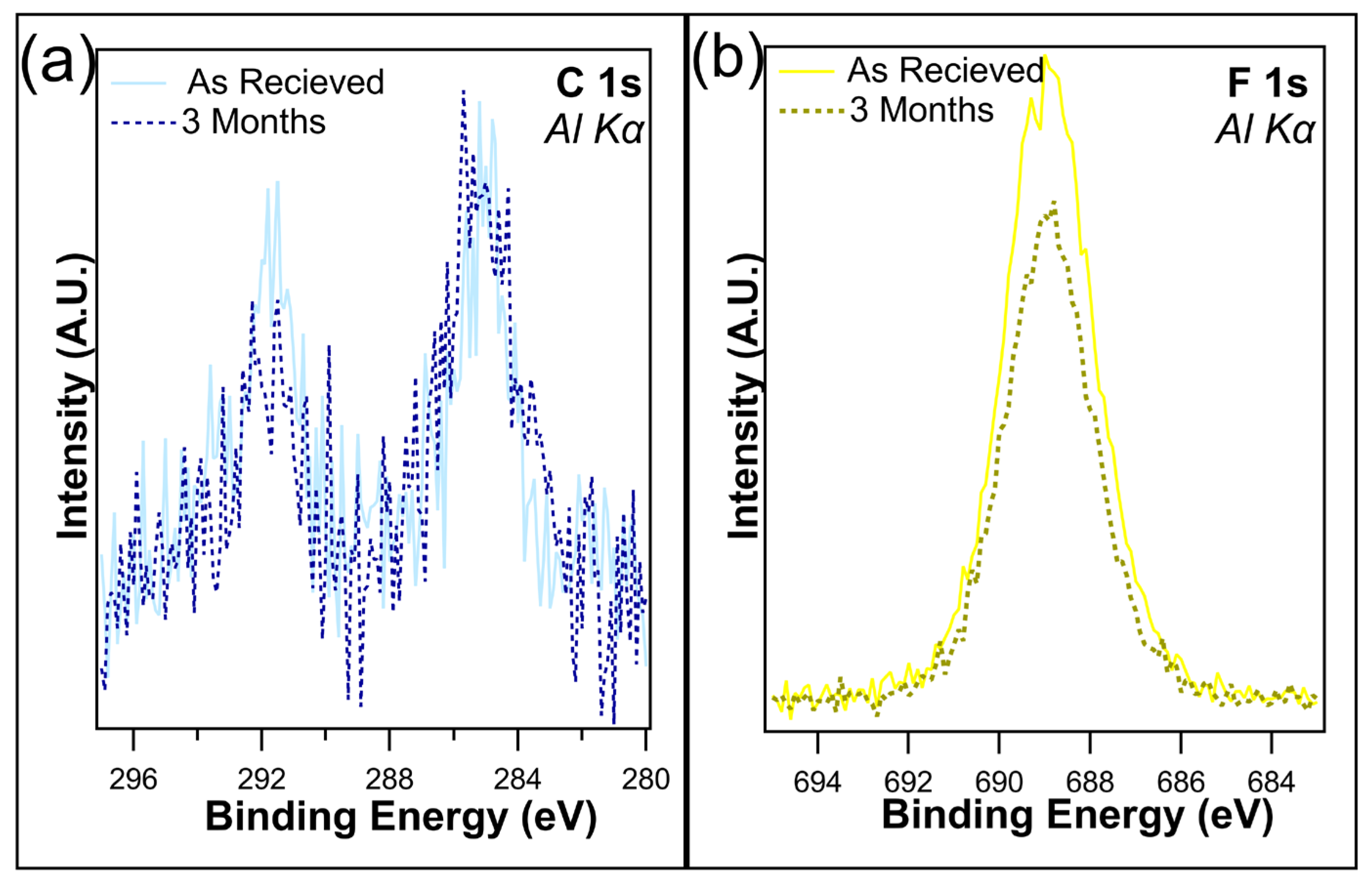
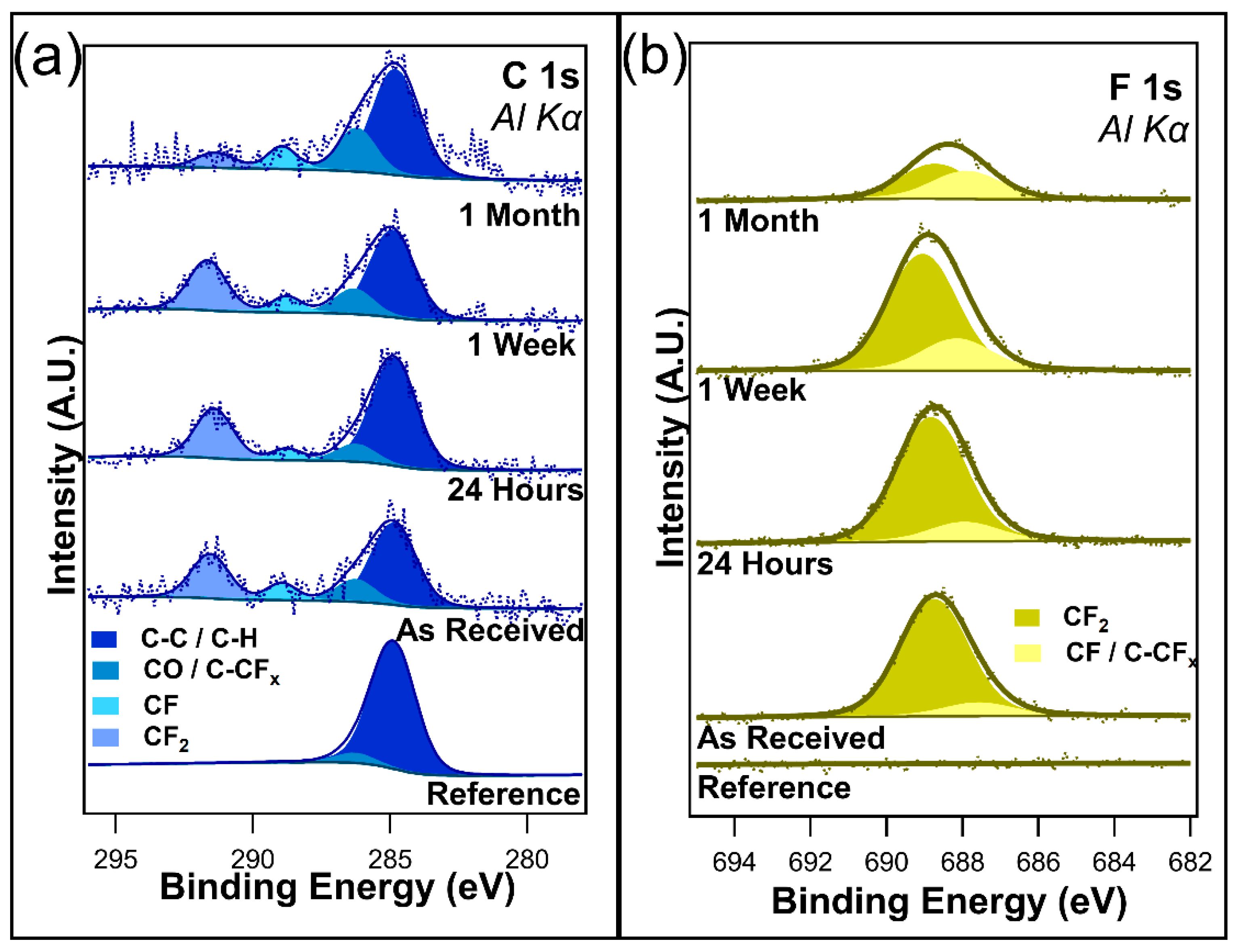
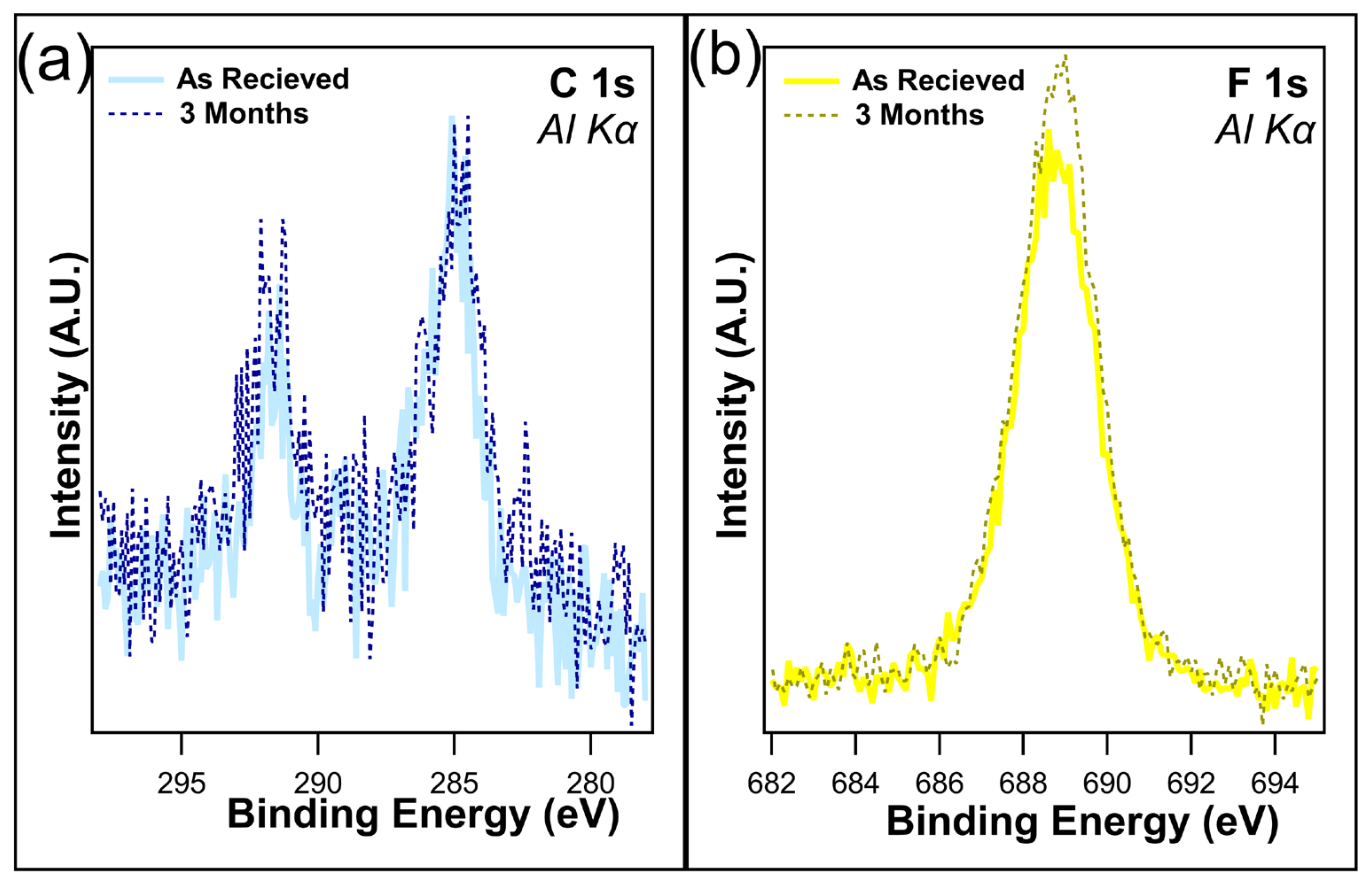
| C 1s % | O 1s % | F 1s % | Si 2p % | |
|---|---|---|---|---|
| Reference SiO2 | 8.2 | 35.1 | 0 | 56.7 |
| As received | 10.6 | 27.2 | 19.1 | 43.1 |
| 24 h ambient exp. | 10.3 | 27.9 | 18.4 | 43.4 |
| 1 week ambient exp. | 11.7 | 27.1 | 16.7 | 44.5 |
| 1 month ambient exp. | 14.2 | 30.2 | 12.9 | 42.7 |
| 1 month in dark conditions | 14.0 | 27.5 | 18.6 | 39.9 |
| 3 months in dark conditions | 12.5 | 29.5 | 17.3 | 40.7 |
| C 1s % | O 1s % | F 1s % | Ti 2p % | |
|---|---|---|---|---|
| Reference TiO2 | 8.4 | 67.2 | 0 | 24.4 |
| As received | 11.5 | 51.9 | 17.6 | 19.0 |
| 24 h ambient exp. | 11.4 | 52.3 | 17.3 | 19.0 |
| 1 week ambient exp. | 10.2 | 53.9 | 15.2 | 20.7 |
| 1 month ambient exp. | 14.4 | 58.5 | 7.4 | 19.7 |
| 1 month in dark conditions | 11.7 | 51.9 | 18.0 | 18.4 |
| 3 months in dark conditions | 11.9 | 50.1 | 18.3 | 19.7 |
Disclaimer/Publisher’s Note: The statements, opinions and data contained in all publications are solely those of the individual author(s) and contributor(s) and not of MDPI and/or the editor(s). MDPI and/or the editor(s) disclaim responsibility for any injury to people or property resulting from any ideas, methods, instructions or products referred to in the content. |
© 2024 by the authors. Licensee MDPI, Basel, Switzerland. This article is an open access article distributed under the terms and conditions of the Creative Commons Attribution (CC BY) license (https://creativecommons.org/licenses/by/4.0/).
Share and Cite
Colbeck Kirby, L.; Lodha, J.K.; Astley, S.; Skelton, D.; Armini, S.; Evans, A.; Brady-Boyd, A. Degradation of Perfluorododecyl-Iodide Self-Assembled Monolayers upon Exposure to Ambient Light. Nanomaterials 2024, 14, 982. https://doi.org/10.3390/nano14110982
Colbeck Kirby L, Lodha JK, Astley S, Skelton D, Armini S, Evans A, Brady-Boyd A. Degradation of Perfluorododecyl-Iodide Self-Assembled Monolayers upon Exposure to Ambient Light. Nanomaterials. 2024; 14(11):982. https://doi.org/10.3390/nano14110982
Chicago/Turabian StyleColbeck Kirby, Lauren, Jayant K. Lodha, Simon Astley, Dave Skelton, Silvia Armini, Andrew Evans, and Anita Brady-Boyd. 2024. "Degradation of Perfluorododecyl-Iodide Self-Assembled Monolayers upon Exposure to Ambient Light" Nanomaterials 14, no. 11: 982. https://doi.org/10.3390/nano14110982





